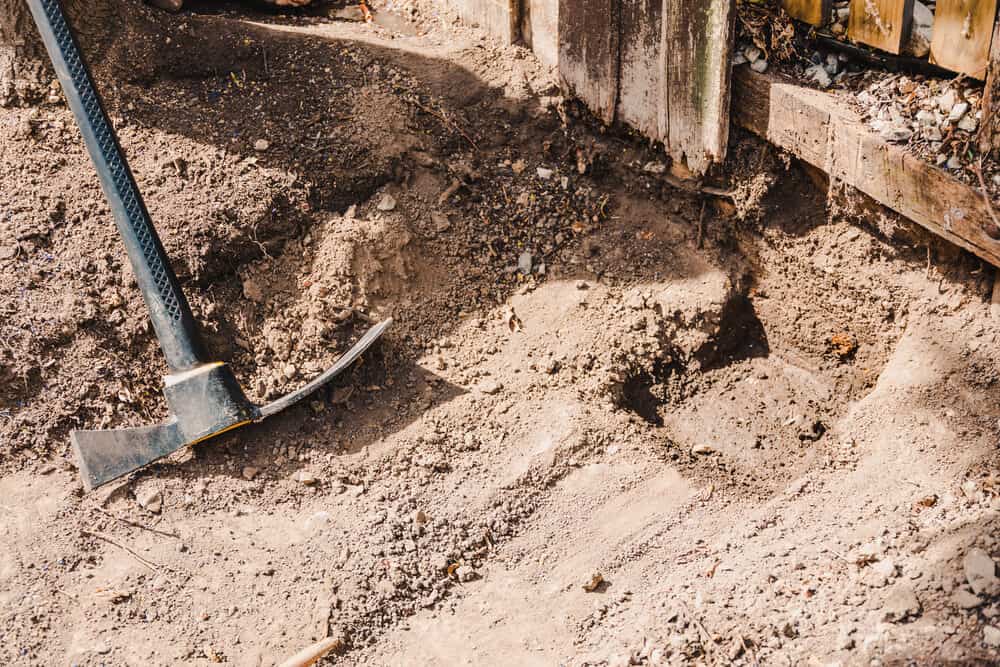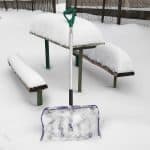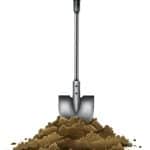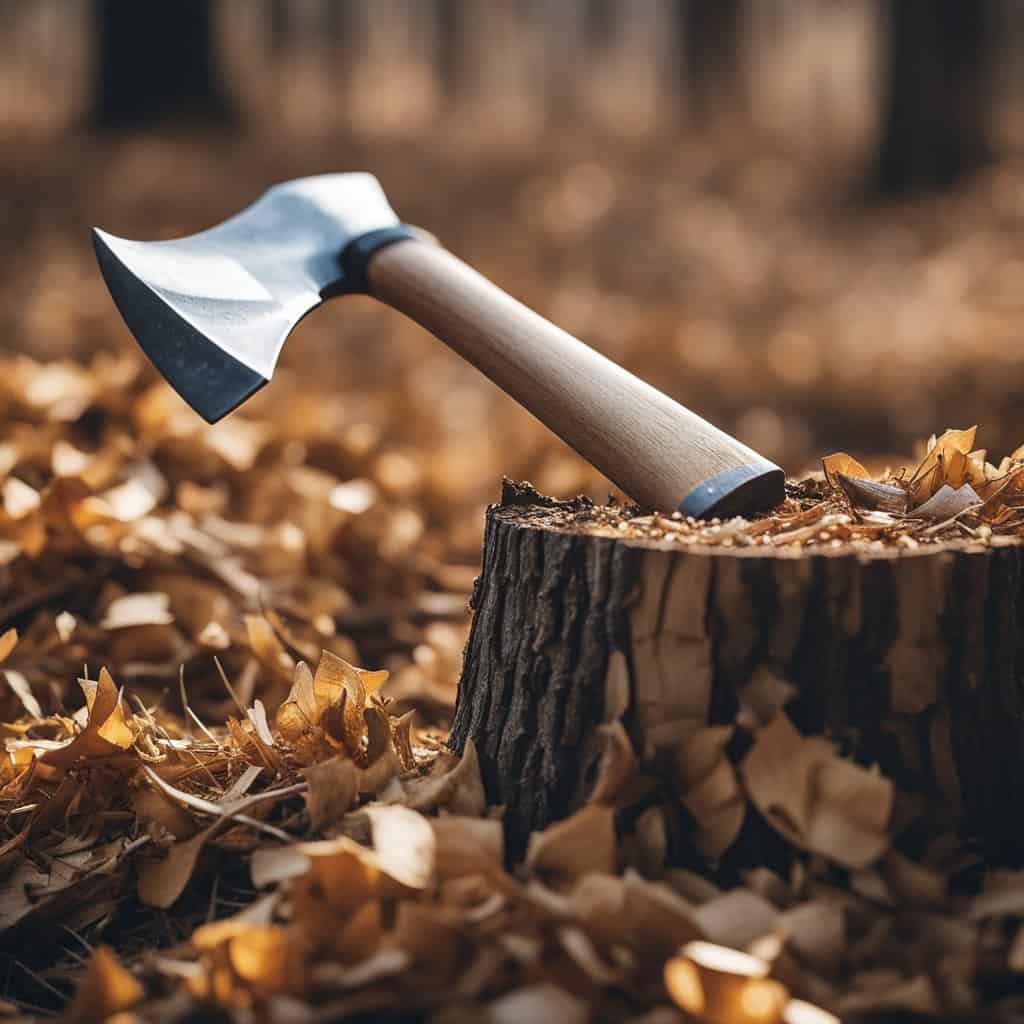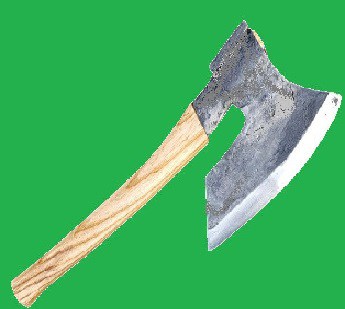The pickaxe is not a traditional axe that chops down trees. Originally it was a tool to clear land for planting and digging up roots, breaking rocks, and removing them. You can use the pickaxe to create a hole like a shovel, and it has similarities to a mattock, much like cousins in a family.
Table of Contents
Parts Of A Pickaxe
You can break down a pickaxe into two main parts: head and handle. The head of the pickaxe also has two components. At one end, there is a point and a transverse blade at the other, which may be a chisel, adze, or hammer.
The pointed end of the head is for breaking up hard surfaces, such as rocks. It breaks up the material’s surface into smaller pieces, whether rock or dirt. The pointed end can pierce materials that are too hard to break by hand.
If the transverse end is an adze, you can use it to level or shape wood. If the transverse end is a chisel, you will utilize this end to break up the ground, rock, roots or create a trench. Lastly, if the transverse end is a hammer, you would be able to pound posts, etc., into the ground.
The Origins Of Pickaxes
A pickaxe is an ancient tool dating back to the stone age. Although it has come a long way from being a stick with a rock on the end, its primary function remains the same today as it was then. This is because the basic design of the pickaxe has stayed relatively unchanged through thousands of years.
The Evolution Of Pickaxes
Though the design is pretty much unchanged, there are some significant developments in its creation from the stone age to today. For example, the head of today’s pickaxes is made out of steel or iron. In earlier times, it was just a rock tied onto a stick with a piece of cord or leather. The handle has also evolved in design and materials from wood to hemp and ceramic, and now fiberglass.
How To Choose The Best Pickaxe For Your Needs?
With so many different pickaxes on the market, it can be challenging to decide which one is best for your needs. The materials of the head, handle, and even the weight are all things to consider before buying one.
Deciding what kind of material you want the head is essential. You want the head to be able to withstand whatever you plan on using it for.
Fiberglass handles are becoming very popular, especially for safety reasons. They do not conduct electricity as metal pickaxe handles do, so working around electric lines is much safer with them.
Different shapes of heads can affect what you will use them for and where. The weight will also depend on what you plan to use it for, and how strong and experienced you are, as pickaxes are heavy and require some finesse.
Pickaxe Head Point Options
There are three main pickaxe head points on the market, round, chisel, and square.
1. Round Pointed End
This head type is perfect for all-around use since you can use it on various surfaces. The downside is that it is easier to slip off surfaces because of the round point. If you need to get into a crack or crevice, this would not be the best option due to its flat shape.
2. Chisel Pointed End
This head type is excellent for splitting into more complex surfaces and better penetrating solid materials. The chisel shape also reduces the chance of slipping in smaller spaces. However, they are unsuitable for breaking straight paths and can crack on thicker surfaces.
3. Square Pointed End
This head type is one of the hardest-wearing options you can get on a pickaxe. It is popular among masonry workers since it does not leave as much surface damage. It is suitable for cutting into harder surfaces and can reduce slipping in smaller spaces. It is very durable and able to withstand a lot of pressure.
4. Diamond Pointed End
The diamond head has the best penetrating power due to its diamond-shaped tip because it does not slip off surfaces as quickly as other tips do, which makes it great for working in tighter spaces. It can also cut and penetrate surface materials but does not last as long as square pointed ends.
Pickaxe Handle Options
1. Fiberglass
Fiberglass handles are gaining popularity because they do not conduct electricity like metal pickaxe handles. They also reduce or eliminate the chance of getting shocked by an electric line. In addition, they are very light and inexpensive and do not splinter like wood ones. However, they crack and break easier than metal handles, but you can expect any fiberglass handle.
2. Wood
Wood handles are the most popular as they are durable and provide a good grip for working. They are also perfect for shock absorption, and the metal cap on the handle will allow you to drive a wedge into more challenging materials. Wood handles cost less than steel handles but can splinter or crack if not used correctly when storing.
3. Steel
Steel Handles are a great option because they provide a good grip for working and do not conduct electricity. However, since they are made out of steel, they can rust if not properly cared for. They are also the most expensive handle option to purchase.
4. Composite
These handles are solid and durable because they use a combination of materials. You still get shock absorption from the fiberglass in the handle, while getting a good grip from the steel. Another benefit of composite handles is that they are easy to replace when needed.
The Different Sizes Of Pickaxes
There are two main sizes in which pickaxe heads come in; mini and regular-sized. Mini pickaxes are great for getting into tighter areas, while regular-sized pickaxes are great for getting into larger spaces. The size you get will depend on your needs, whether you are using the pickaxe for mining, gardening, or breaking up materials.
List Of Different Types Of Pickaxes and Where They Are Used
There are different types of pickaxes for various purposes, including:
a. Hoe/Shovel – for hoeing or shoveling earth and removing snow or ice
b. Sappers, which are used in construction. Sappers are long and have a pointed end on one end and a broad end on the other that is designed to break up rocks
c. Rammers – A rammer is mainly used in demolition work where the item to be destroyed is hit with a heavyweight, e.g., to break up concrete or brick walls.
When To Use A Pickaxe
Pickaxes are used for heavier tasks such as landscape and construction, to loosen or break up the ground, and rocks for construction materials such as bricks and concrete blocks when building a house or other structure.
Pickaxes are also used for mining and have been since ancient Egypt. So the pickaxe is the tool of choice in mining to dig tunnels and break up the rocks inside. In addition, you can use pickaxes to dig holes for planting plants or trees or building a fence.
What Is The Difference Between A Pickaxe And A Mattock?
If you’re a gardener, you may wonder if a mattock is better than a pickaxe. The difference between pickaxes and mattocks is that a mattocks head has a broader transverse blade and a pick or axe on the opposite end, making it suitable for digging, prying, and chopping.
Mattocks can be made from metal or wood, while pickaxes are typically metal. Mattocks are primarily for digging and cutting through roots, while pickaxes are more versatile and can be used for various tasks, so you will need to choose based on your needs.
Tips In Using A Pickaxe
When picking rocks or logs with a pickaxe, always use a safety helmet.
Stay aware of your surroundings while working with a pickaxe to avoid dangerous falls or accidents that could occur while using the tool. Below is a video demonstrating the best way to swing a pickaxe.
Final Thoughts
There are many pickaxes and combinations of pickaxe heads to choose from, and each one has its specific benefits, combination, name and style. Consider the following when purchasing:
-The weight and size of the pickaxe
-The type of pickaxe head required: chisel, adze, or hoe
-The quality of the blade and handle, brand, and price
Our Pick Axe Choices
Below are our choices of best all round, best for budget conscious buyer and the runner up.
Best All Round
Our choice of best all round is Estwing Geo/Paleo Rock Pick – 25″ Geological Tool with All Steel Construction & Vinyl Cushion Grip – GP-100,GP100,Blue pick axe. It is made from on solid piece, has a pointed end and a chisel end and is extremely durable. The pick end pentrates clay and rocks easily, cracking materials out of your way.
Best For Budget Conscious Buyer
Our choice for the budget conscious buyer, that offers versatility for a number of tasks is Hooyman Pick Mattock with Heavy Duty Forged Head Construction, Solid Fiberglass Core, Ergonomic No-Slip H-Grip Handle, Garden Pick Axe, and Adze Hoe for Gardening, Landscaping, Yard Work, and Outdoors Many pickaxes are heavy to carry and heavy to weild over your shoulder and strike the ground. This pickaxe is lighter weight allowing user of various backgrounds to successfully negotiate. The blade is narrower than others but for some projects a narrower blade is just what is needed.
Runner up
Our runner up is the Fiskars 751210-1002 Garden IsoCore 5 lb Pick, 36 Inch, Orange/Black This mattock will break through hard, compacted earth in not ime at all. WHere other pickaxes could hardly make a dent this mattock pentrates the ground easily. Whether crushed or packed rock and packed clay using this mattock will amaze you.

